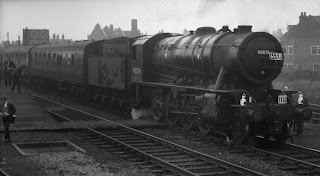The first stop today is disappointing as the Jug at Chapel Haddlesey is now closed. A shame, as it was good 'un.
There was a water softening plant in the yard.
Drax once had two stations. Drax Hales was on the ex NER Selby to Goole line (My collection - photographer unknown).
A spur from the H&B leads into Drax Power Station.
Closer to Goole was Airmyn & Rawcliffe station (My collection - photographer unknown).
There used to be a ferry at Airmyn, across the Ouse.
In the outskirts of Goole was the yard of Advance Coaches, seen on a freezing day in the mid 1970s.
On the approaches to Goole is this West Riding Daimler Fleetline.
Sweyne Coaches are still in business, but seem to have now given up stage carriage work.
Hanson, a local contractor, kept vehicles in the railway station yard.
Goole station is a two platform affair. It was built by the NER. Here's an unusual vehicle!
A more conventional service, a Doncaster to Hull local, approaching the station, circa 1932.
On the 8th of October 1966, a railtour reached Goole headed by WD no. 90076.
A Metro-Cammell DMU rests in the siding beside Goole station in the early 1970s.
A few years later and a refurbished DMU calls.
In the early 1980s, the goods shed was used to stable locomotives.
On the same occasion, a down HST arrives.
Northern operates all the services in modern times.
The Macintosh is a traditional boozer, but no real ale these days.
There's a Wetherspoons, the City & County.
One's best bet for real ale is the excellent micropub, the Tom Pudding.
Want to know what a Tom Pudding is? Find out in the next post, when we see more of Goole and head out towards Lincolnshire. As always, here's a link to the route so far.




































































